Social-Ecological Dynamics of Ecosystem Services: Livelihoods and the Functional Relation between Ecosystem Service Supply and Demand—Evidence from Socotra Archipelago, Yemen and the Sahel Region, West Africa
Abstract
:1. Introduction
2. Conceptual Reflection: The Social-Ecological Perspective
3. The Social-Ecological Dynamics of Ecosystem Services: Empirical Evidence
3.1. Spatial Dynamics of Ecosystem Services Supply and Demand: The Case of the West African Sahel
3.2. Temporal Dynamics of Ecosystem Service Supply and Demand: The Case of Socotra Archipelago, Yemen
4. Discussion
5. Conclusions
- ▪
- ES supply and demand stand in a functional rather than a static and linear relation to each other: nature and society exert mutual influence. Changes in ES supply can impact on ES demand and vice versa.
- ▪
- there are interdependent temporal and spatial dynamics in both ES supply and ES demand.
Acknowledgments
Author Contributions
Conflicts of Interest
References
- Secretariat of the Convention on Biological Diversity. Global Biodiversity Outlook 4: A Mid-Term Assessment of Progress towards the Implementation of the Strategic Plan for Biodiversity 2011–2020; Secretariat for the Convention on Biological Diversity: Montreal, QC, Canada, 2014. [Google Scholar]
- Tittensor, D.P.; Walpole, M.; Hill, S.L.L.; Boyce, D.G.; Britten, G.L.; Burgess, N.D.; Butchart, S.H.M.; Leadley, P.W.; Regan, E.C.; Alkemade, R.; et al. A mid-term analysis of progress toward international biodiversity targets. Science 2014, 346, 241–244. [Google Scholar] [CrossRef] [PubMed]
- Chapin, F.S.C., III; Zavaleta, E.S.; Eviner, V.T.; Naylor, R.L.; Vitousek, P.M.; Reynolds, H.L.; Hooper, D.U.; Lavorel, S.; Sala, O.E.; Hobbie, S.E.; et al. Consequences of changing biodiversity. Nature 2000, 405, 234–242. [Google Scholar] [CrossRef] [PubMed]
- Cardinale, B.J.; Duffy, J.E.; Gonzalez, A.; Hooper, D.U.; Perrings, C.; Venail, P.; Narwani, A.; Mace, G.M.; Tilman, D.; Wardle, D.A.; et al. Biodiversity loss and its impact on humanity. Nature 2012, 486, 59–67. [Google Scholar] [CrossRef] [PubMed]
- Burkhard, B.; Kroll, F.; Nedkov, S.; Müller, F. Mapping ecosystem service supply, demand and budgets. Ecol. Indic. 2012, 21, 17–29. [Google Scholar] [CrossRef]
- Schröter, M.; Barton, D.N.; Remme, R.P.; Hein, L. Accounting for capacity and flow of ecosystem services: A conceptual model and a case study for Telemark, Norway. Ecol. Indic. 2014, 36, 539–551. [Google Scholar] [CrossRef]
- TEEB. The Economics of Ecosystems & Biodiversity: An Interim Report; E ISB N-1 3 978-9 2-79-0; European Commission and the German Ministry for the Environment: Wesseling, Germany, 2008. [Google Scholar]
- Ten Brink, P. (Ed.) The Economics of Ecosystems and Biodiversity in National and International Policy Making; Earthscan: London, UK, 2011. [Google Scholar]
- Carpenter, S.R.; Mooney, H.A.; Agard, J.; Capistrano, D.; Defries, R.S.; Diaz, S.; Dietz, T.; Duraiappah, A.K.; Oteng-Yeboah, A.; Pereira, H.M.; et al. Science for managing ecosystem services: Beyond the Millennium Ecosystem Assessment. Proc. Natl. Acad. Sci. USA 2009, 106, 1305–1312. [Google Scholar] [CrossRef] [PubMed]
- Stoll, S.; Frenzel, M.; Burkhard, B.; Adamescu, M.; Augustaitis, A.; Baeßler, C.; Bonet, F.J.; Carranza, M.L.; Cazacu, C.; Cosor, G.L.; et al. Assessment of ecosystem integrity and service gradients across Europe using the LTER Europe network. Ecol. Model. 2015, 295, 75–87. [Google Scholar] [CrossRef]
- Görg, C.; Aicher, C. Ökosystemdienstleistungen-zwischen Natur und Gesellschaft. Anforderungen an eine inter-und transdisziplinäre Forschung aus Sicht der Sozialwissenschaften. In Berichte und Abhandlungen: Band 16; Berlin-Brandenburgische Akademie der Wissenschaften (Hg.), Ed.; De Gruyter Akademie Forschung: Berlin, Germany, 2014. [Google Scholar]
- Loft, L.; Lux, A.; Jahn, T. A Social-Ecological Perspective on Ecosystem Services. In Handbook of Ecosystem Services; Potschin, M., Haines-Young, R., Fish, R., Turner, R., Eds.; Routledge: Abingdon, UK, 2016; pp. 88–94. [Google Scholar]
- Stürck, J.; Schulp, C.J.; Verburg, P.H. Spatio-temporal dynamics of regulating ecosystem services in Europe—The role of past and future land use change. Appl. Geogr. 2015, 63, 121–135. [Google Scholar] [CrossRef]
- Burkhard, B.; Petrosillo, I.; Costanza, R. Ecosystem services—Bridging ecology, economy and social sciences. Ecol. Complexity 2010, 7, 257–259. [Google Scholar] [CrossRef]
- Hummel, D.; Jahn, T.; Keil, F.; Liehr, S.; Stieß, I. Social Ecology as Critical, Transdisciplinary Science—Conceptualizing, Analyzing, and Shaping Societal Relations to Nature. Sustainability 2017. accepted. [Google Scholar]
- Liehr, S.; Röhrig, J.; Mehring, M.; Kluge, T. How the Social-Ecological Systems Concept Can Guide Transdisciplinary Research and Implementation: Addressing Water Challenges in Central Northern Namibia. Sustainability 2017. accepted. [Google Scholar]
- Mace, G.M.; Norris, K.; Fitter, A.H. Biodiversity and ecosystem services: A multilayered relationship. Trends Ecol. Evol. 2012, 27, 19–26. [Google Scholar] [CrossRef] [PubMed]
- Balvanera, P.; Siddique, I.; Dee, L.; Paquette, A.; Isbell, F.; Gonzalez, A.; Byrnes, J.; O’Connor, M.I.; Hungate, B.A.; Griffin, J.N. Linking Biodiversity and Ecosystem Services: Current Uncertainties and the Necessary Next Steps. BioScience 2014, 64, 49–57. [Google Scholar] [CrossRef]
- Martín-López, B.; Montes, C. Restoring the human capacity for conserving biodiversity: A social–ecological approach. Sustain. Sci. 2015, 10, 699–706. [Google Scholar] [CrossRef]
- Ban, N.C.; Mills, M.; Tam, J.; Hicks, C.C.; Klain, S.; Stoeckl, N.; Bottrill, M.C.; Levine, J.; Pressey, R.L.; Satterfield, T.; et al. A social–ecological approach to conservation planning: Embedding social considerations. Front. Ecol. Environ. 2013, 11, 194–202. [Google Scholar] [CrossRef]
- Fischer, J.; Gardner, T.A.; Bennett, E.M.; Balvanera, P.; Biggs, R.; Carpenter, S.; Daw, T.; Folke, C.; Hill, R.; Hughes, T.P.; et al. Advancing sustainability through mainstreaming a social–ecological systems perspective. Curr. Opin. Environ. Sustain. 2015, 14, 144–149. [Google Scholar] [CrossRef]
- Mehring, M.; Bernard, B.; Hummel, D.; Liehr, S.; Lux, A. Halting biodiversity loss: How social–ecological biodiversity research makes a difference. Int. J. Biodivers. Sci. Ecosyst. Serv. Manag. 2017, 13, 172–180. [Google Scholar] [CrossRef]
- Schleyer, C.; Lux, A.; Mehring, M.; Görg, C. Ecosystem Services as a boundary concept: Social-ecological perspective on a contested concept and the need for inter- and transdisciplinary collaboration. Sustainability 2017. submitted. [Google Scholar]
- European Commission. The EU Biodiversity Strategy to 2020; Publications Offfice of the European Union: Luxembourg, 2011. [Google Scholar]
- Díaz, S.; Demissew, S.; Carabias, J.; Joly, C.; Lonsdale, M.; Ash, N.; Larigauderie, A.; Adhikari, J.R.; Arico, S.; Báldi, A.; et al. The IPBES Conceptual Framework—Connecting nature and people. Curr. Opin. Environ. Sustain. 2015, 14, 1–16. [Google Scholar] [CrossRef]
- Albert, C.; Bonn, A.; Burkhard, B.; Daube, S.; Dietrich, K.; Engels, B.; Frommer, J.; Götzl, M.; Grêt-Regamey, A.; Job-Hoben, B.; et al. Towards a national set of ecosystem service indicators: Insights from Germany. Ecol. Indic. 2015, 61, 38–48. [Google Scholar] [CrossRef]
- Villamagna, A.M.; Angermeier, P.L.; Bennett, E.M. Capacity, pressure, demand, and flow: A conceptual framework for analyzing ecosystem service provision and delivery. Ecol. Complex. 2013, 15, 114–121. [Google Scholar] [CrossRef]
- Martínez-Harms, M.J.; Balvanera, P. Methods for mapping ecosystem service supply: A review. Int. J. Biodivers. Sci. Ecosyst. Serv. Manag. 2012, 8, 17–25. [Google Scholar] [CrossRef]
- Wolff, S.; Schulp, C.; Verburg, P.H. Mapping ecosystem services demand: A review of current research and future perspectives. Ecol. Indic. 2015, 55, 159–171. [Google Scholar] [CrossRef]
- Chan, K.M.A.; Balvanera, P.; Benessaiah, K.; Chapman, M.; Diaz, S.; Gomez-Baggethun, E.; Gould, R.; Hannahs, N.; Jax, K.; Klain, S.; et al. Opinion: Why protect nature? Rethinking values and the environment. Proc. Natl. Acad. Sci. USA 2016, 113, 1462–1465. [Google Scholar] [CrossRef] [PubMed]
- Daw, T.M.; Hicks, C.C.; Brown, K.; Chaigneau, T.; Januchowski-Hartley, F.A.; Cheung, W.W.L.; Rosendo, S.; Crona, B.; Coulthard, S.; Sandbrook, C.; et al. Elasticity in ecosystem services: Exploring the variable relationship between ecosystems and human well-being. Ecol. Soc. 2016, 21. [Google Scholar] [CrossRef]
- Hummel, D. Climate change, land degradation and migration in Mali and Senegal—Some policy implications. Migr. Dev. 2016, 5, 211–233. [Google Scholar] [CrossRef]
- Brandt, M.; Romankiewicz, C.; Spiekermann, R.; Samimi, C. Environmental change in time series—An interdisciplinary study in the Sahel of Mali and Senegal. J. Arid Environ. 2014, 105, 52–63. [Google Scholar] [CrossRef]
- Brandt, M.; Verger, A.; Diouf, A.; Baret, F.; Samimi, C. Local Vegetation Trends in the Sahel of Mali and Senegal Using Long Time Series FAPAR Satellite Products and Field Measurement (1982–2010). Remote Sens. 2014, 6, 2408–2434. [Google Scholar] [CrossRef]
- Van der Land, V. The Environment-Migration Nexus Reconsidered: Why Capabilities and Aspirations Matter. Ph.D. Thesis, Universität Goethe, Frankfurt am Main, Germany, 2015. [Google Scholar]
- Liehr, S.; Drees, L.; Hummel, D. Migration as Societal Response to Climate Change and Land Degradation in Mali and Senegal. In Adaptation to Climate Change and Variability in Rural West Africa; Yaro, J.A., Hesselberg, J., Eds.; Springer: Heidelberg, Germany, 2016; pp. 147–169. [Google Scholar]
- Roudier, P.; Sultan, B.; Quirion, P.; Berg, A. The impact of future climate change on West African crop yields: What does the recent literature say? Glob. Environ. Chang. 2011, 21, 1073–1083. [Google Scholar] [CrossRef]
- Sissoko, K.; van Keulen, H.; Verhagen, J.; Tekken, V.; Battaglini, A. Agriculture, livelihoods and climate change in the West African Sahel. Reg. Environ. Chang. 2011, 11, 119–125. [Google Scholar] [CrossRef]
- Pardoe, J.; Kloos, J.; Assogba, N.P. Seasonal Variability: Impacts, Adaptations and the Sustainability Challenge. In Adaptation to Climate Change and Variability in Rural West Africa; Yaro, J.A., Hesselberg, J., Eds.; Springer: Heidelberg, Germany, 2016; pp. 41–57. [Google Scholar]
- KC, S.; Lutz, W. Demographic, Migration and Human Capital Scenarios for Mali and Senegal with Special Emphasis on Bandiagara and Linguere Districts: Final Report of the Demographic Analysis in the Micle-Project; ISOE—Institute for Social-Ecological Research: Frankfurt am Main, Germany, 2014. [Google Scholar]
- Van der Land, V.; Hummel, D. Vulnerability and the Role of Education in Environmentally Induced Migration in Mali and Senegal. Ecol. Soc. 2013, 18, 414. [Google Scholar] [CrossRef]
- Scholte, P.; Al-Okaishi, A.; Suleyman, A.S. When conservation precedes development: A case study of the opening up of the Socotra archipelago, Yemen. Oryx 2011, 45, 401–410. [Google Scholar] [CrossRef]
- Van Damme, K.; Banfield, L. Past and present human impacts on the biodiversity of Socotra Island (Yemen): Implications for future conservation. Zool. Middle East 2013, 54, 31–88. [Google Scholar] [CrossRef]
- Cheung, C.; DeVantier, L. Socotra: A Natural History of the Islands and Their People; Odyssey Books & Guides: Hong Kong, China, 2006. [Google Scholar]
- Morris, M. Manual of Traditional Land Use in the Soqotra Archipelago: GEF YEM/96/G32; Royal Botanic Garden Edinburgh: Edinburgh, UK, 2002. [Google Scholar]
- Miller, A.G.; Morris, M. Ethnoflora of the Soqotra Archipelago; Royal Botanic Garden Edinburgh: Edinburgh, UK, 2004. [Google Scholar]
- UNDP. Human Development Report 2016; United Nations: New York, NY, USA, 2017. [Google Scholar]
- Goerres, M. Coastal and Terrestrial Ecosystem Services, Uses and Users: A Case Study From Socotra Island, Yemen. Bachelor’s Thesis, Johannes Gutenberg-Universität Mainz, Mainz, Germany, March 2011. [Google Scholar]
- Aideed, M.S. Spatial and Temporal Dynamics of Fish Biomass Productivity at Socotra Island and the Impact of Small-Scale Fisheries on Fish Community Structure. Master’s Thesis, Hadrahmout University, Mukallah, Yemen, December 2013. [Google Scholar]
- Martin, M. Vulnerability of Fishery-Based Social-Ecological Systems to Climate Change. A Case Study on the Small-Scale Fishery of Soqotra Island, Yemen. Master’s Thesis, Goethe-University, Frankfurt am Main, Germany, November 2013. [Google Scholar]
- Zajonz, U.; Lavergne, E.; Klaus, R.; Krupp, F.; Aideed, M.S.; Saeed, F.N. The coastal fishes and fisheries of the Socotra Archipelago, Yemen. Mar. Pollut. Bull. 2016, 105, 660–675. [Google Scholar] [CrossRef] [PubMed]
- Lavergne, E.; Zajonz, U.; Sellin, L. Length-weight relationship and seasonal effects of the Summer Monsoon on condition factor of Terapon jarbua (Forsskål, 1775) from the wider Gulf of Aden including Socotra Island. J. Appl. Ichthyol. 2013, 29, 274–277. [Google Scholar] [CrossRef]
- Zajonz, U.; Sheikh Aideed, M.; Martin, M.; Naseeb Saeed, F.; Lavergne, E. Unpublished data.
- Martin, M.; Zajonz, U.; Hummel, D.; Sheikh Aideed, M.; Naseeb Saeed, F. Unpublished data.
- Van Rampelbergh, M.; Fleitmann, D.; Verheyden, S.; Cheng, H.; Edwards, L.; de Geest, P.; de Vleeschouwer, D.; Burns, S.J.; Matter, A.; Claeys, P.; et al. Mid—To late Holocene Indian Ocean Monsoon variability recorded in four speleothems from Socotra Island, Yemen. Quat. Sci. Rev. 2013, 65, 129–142. [Google Scholar] [CrossRef]
- Allison, E.H.; Perry, A.L.; Badjeck, M.-C.; Neil Adger, W.; Brown, K.; Conway, D.; Halls, A.S.; Pilling, G.M.; Reynolds, J.D.; Andrew, N.L.; et al. Vulnerability of national economies to the impacts of climate change on fisheries. Fish Fish. 2009, 10, 173–196. [Google Scholar] [CrossRef]
- Burkhard, B.; Kandziora, M.; Hou, Y.; Müller, F. Ecosystem Service Potentials, Flows and Demands—Concepts for Spatial Localisation, Indication and Quantification. Landsc. Oniline 2014, 34, 1–32. [Google Scholar] [CrossRef]
- Raudsepp-Hearne, C.; Peterson, G.D.; Bennett, E.M. Ecosystem service bundles for analyzing tradeoffs in diverse landscapes. Proc. Natl. Acad. Sci USA 2010, 107, 5242–5247. [Google Scholar] [CrossRef] [PubMed]
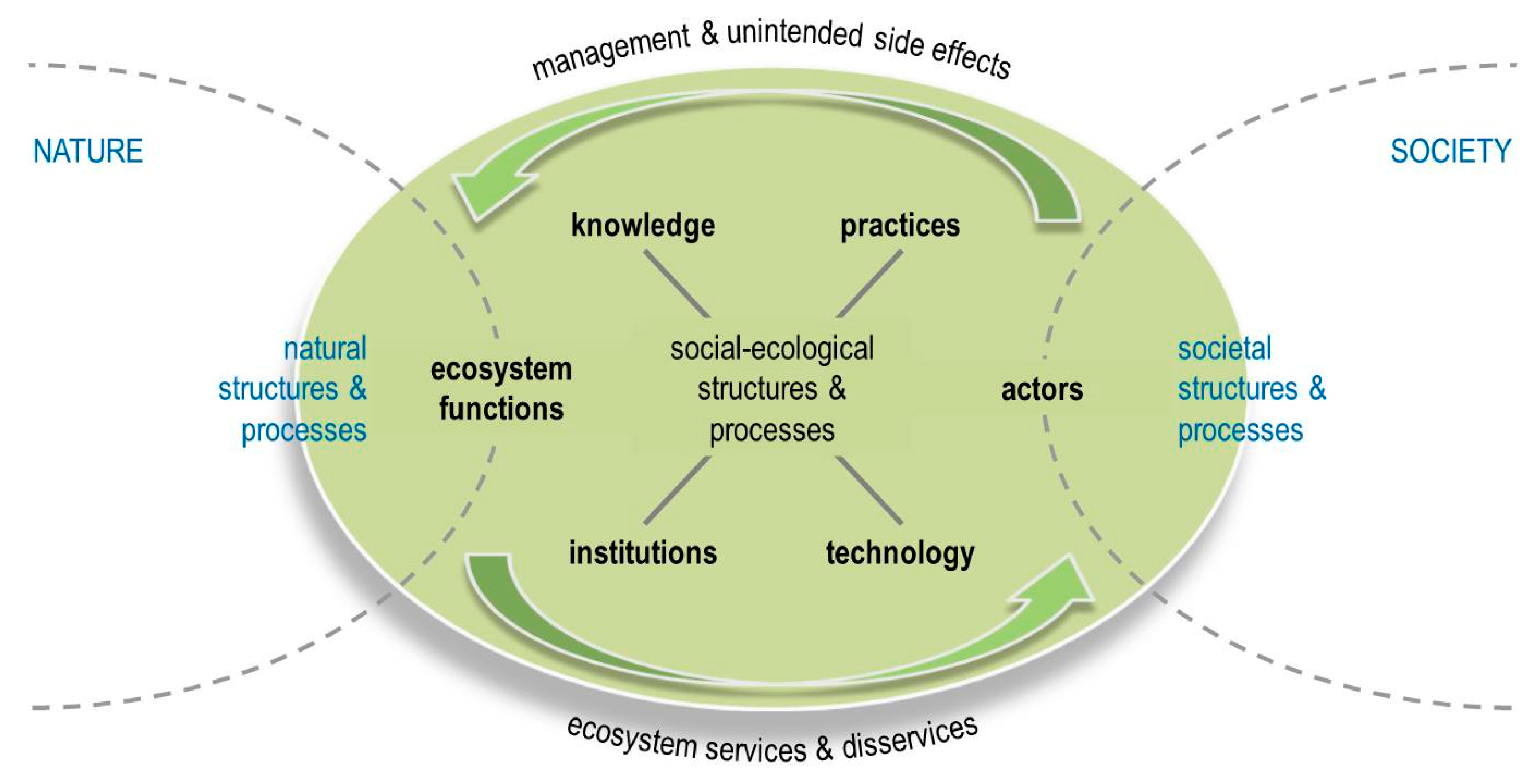
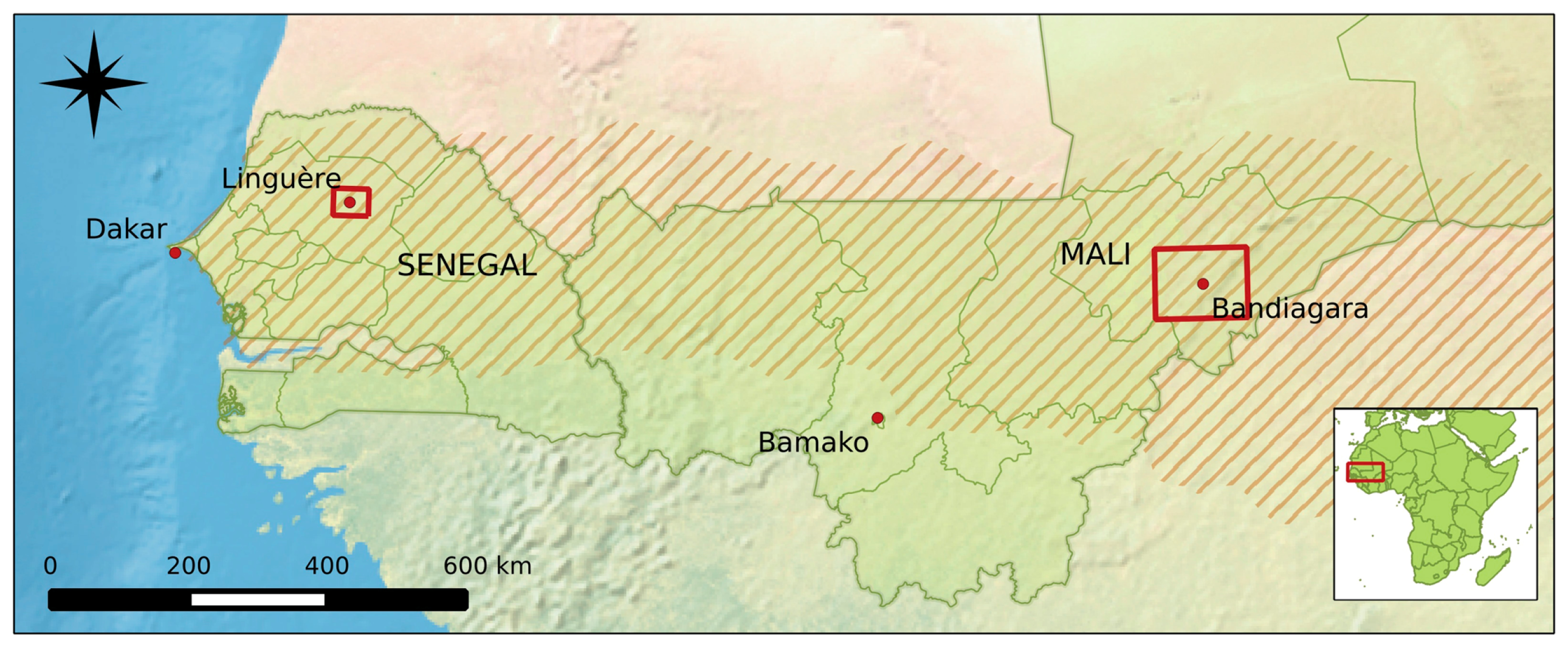
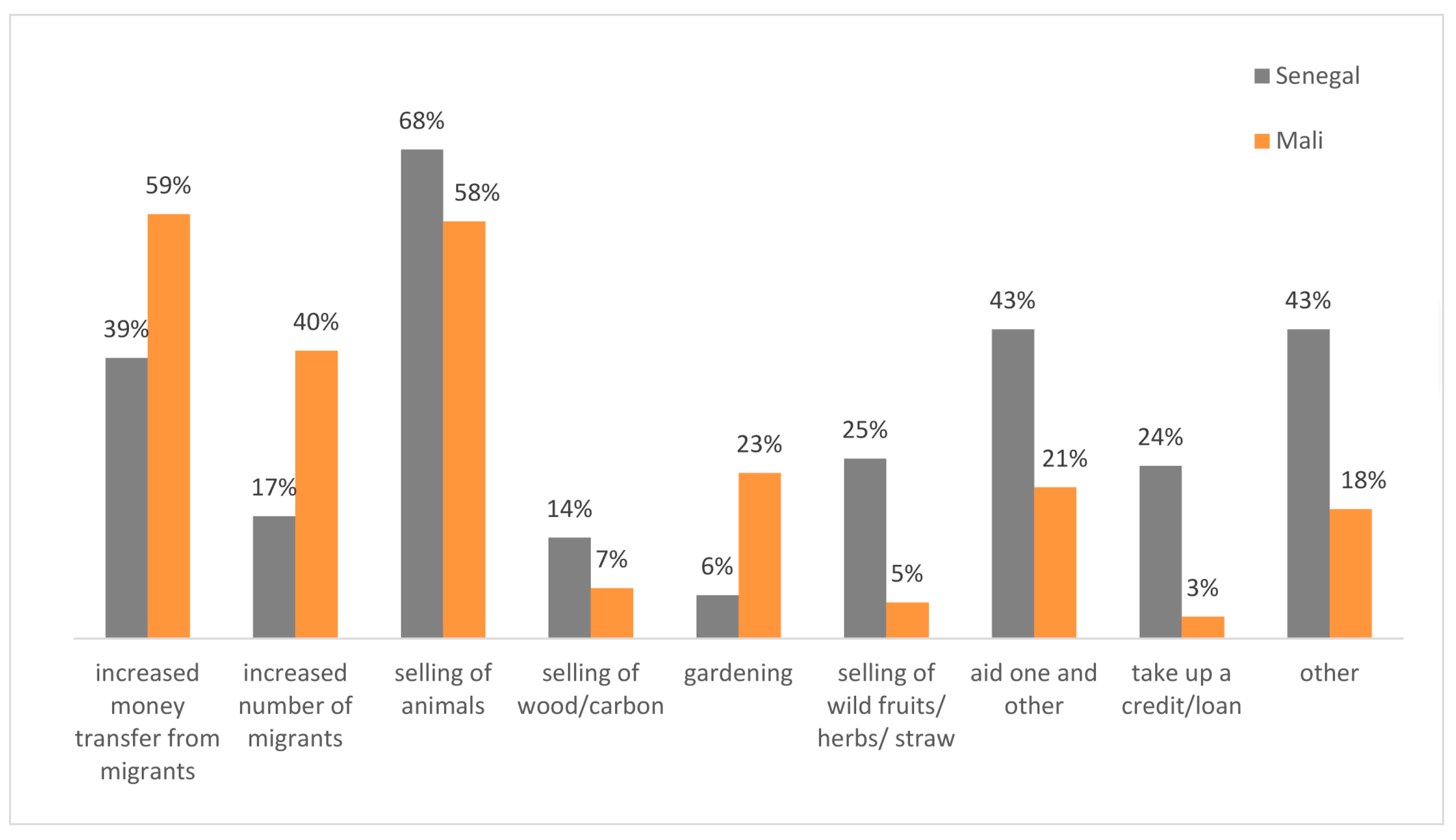
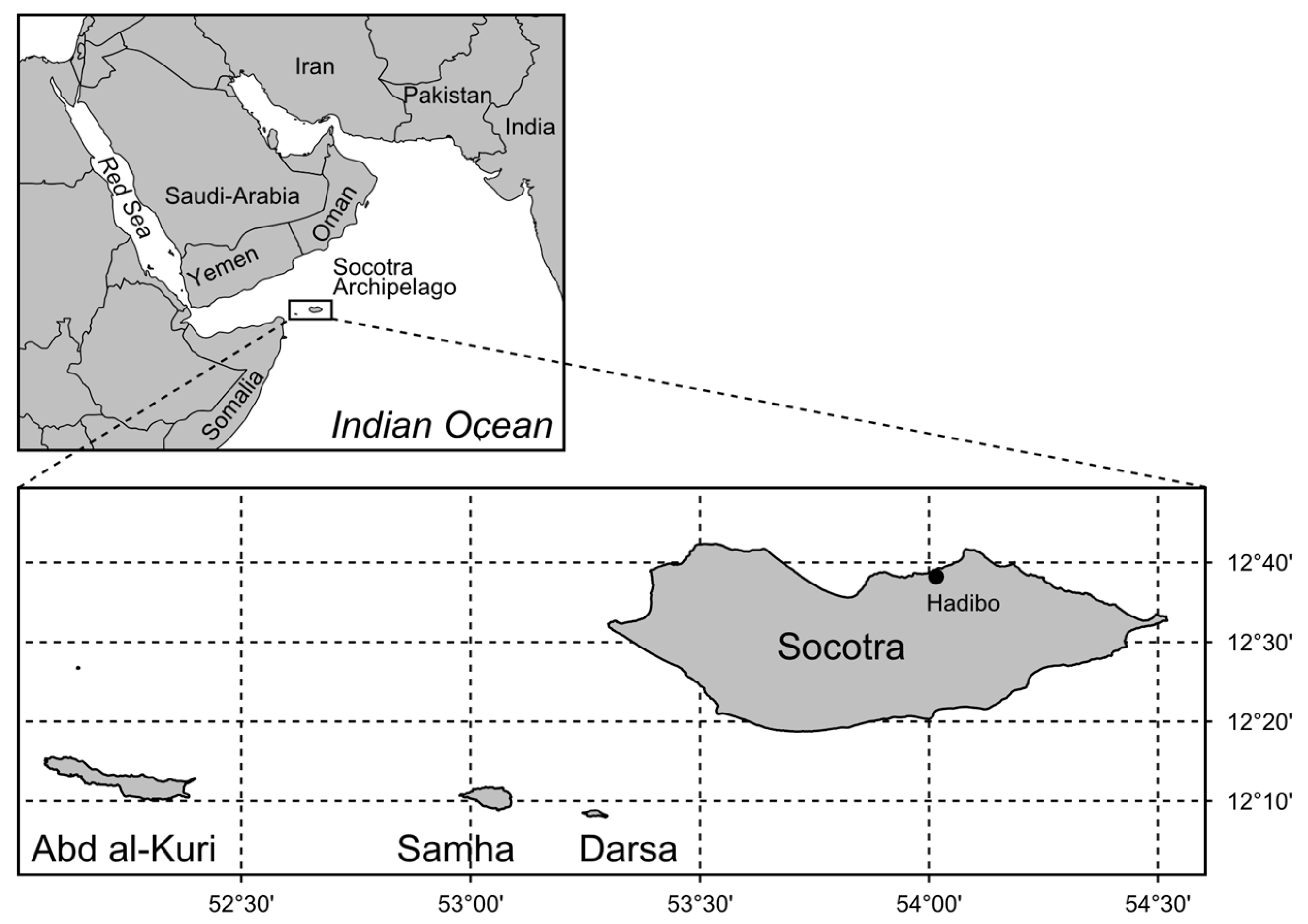

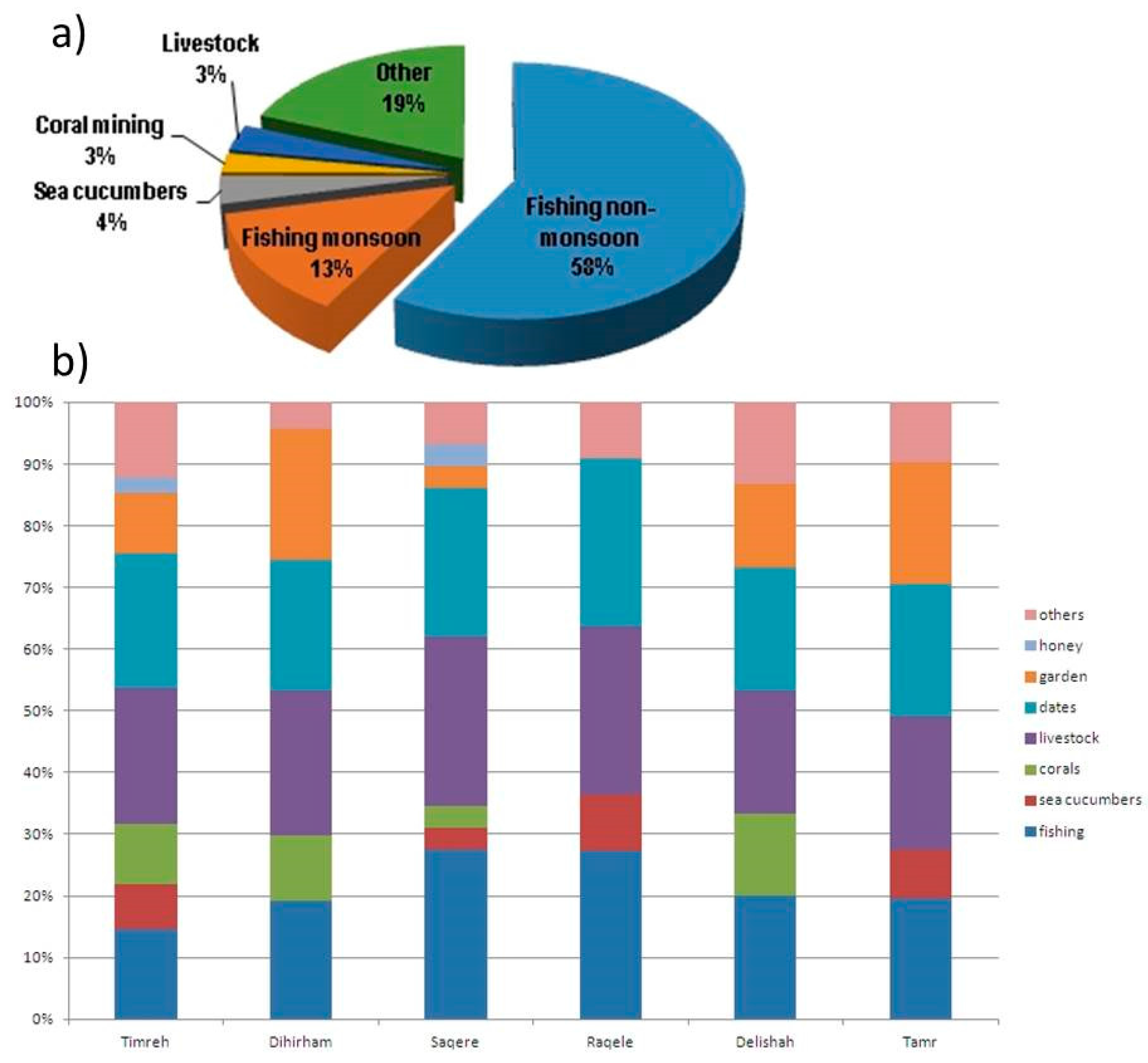
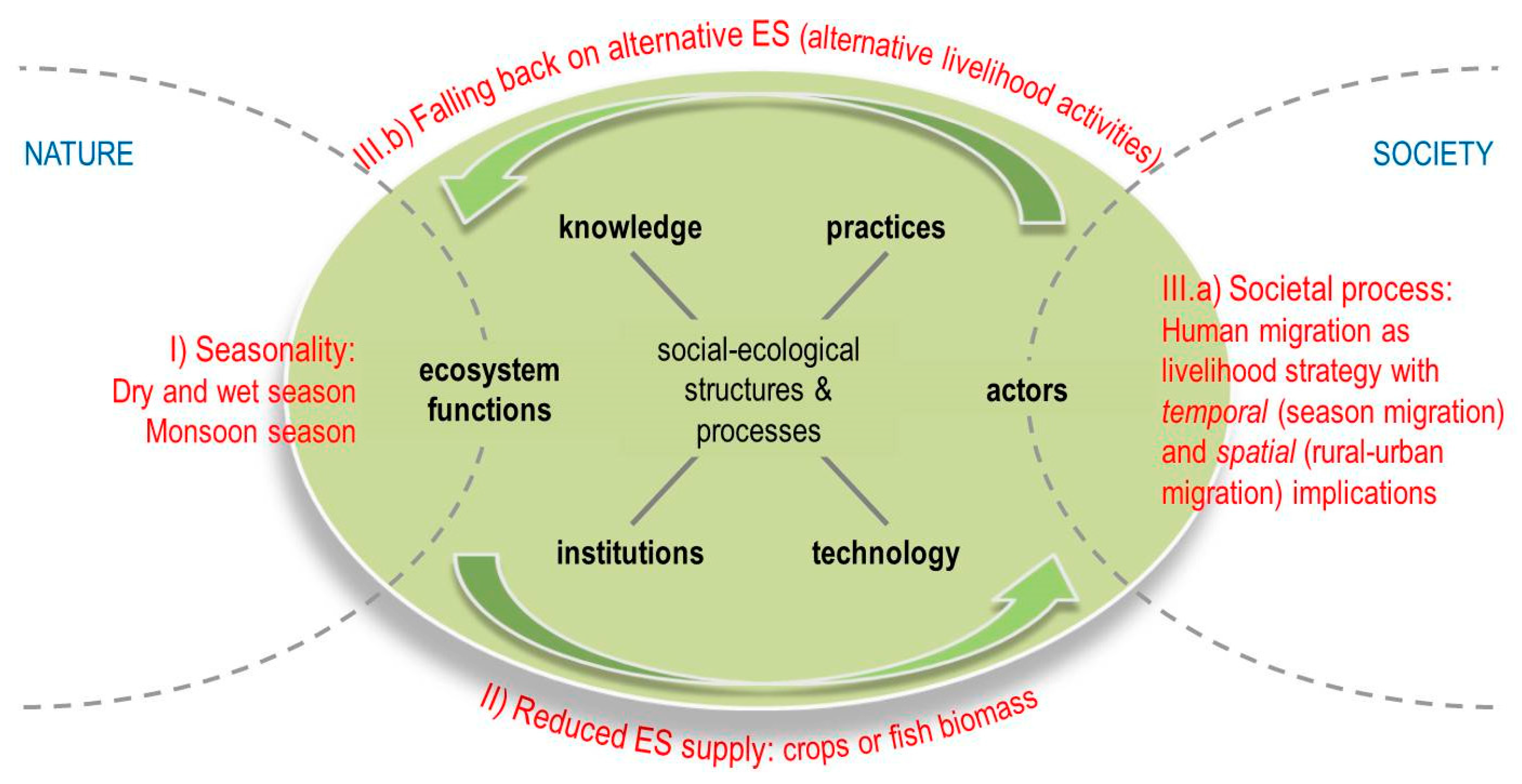
© 2017 by the authors. Licensee MDPI, Basel, Switzerland. This article is an open access article distributed under the terms and conditions of the Creative Commons Attribution (CC BY) license (http://creativecommons.org/licenses/by/4.0/).
Share and Cite
Mehring, M.; Zajonz, U.; Hummel, D. Social-Ecological Dynamics of Ecosystem Services: Livelihoods and the Functional Relation between Ecosystem Service Supply and Demand—Evidence from Socotra Archipelago, Yemen and the Sahel Region, West Africa. Sustainability 2017, 9, 1037. https://doi.org/10.3390/su9071037
Mehring M, Zajonz U, Hummel D. Social-Ecological Dynamics of Ecosystem Services: Livelihoods and the Functional Relation between Ecosystem Service Supply and Demand—Evidence from Socotra Archipelago, Yemen and the Sahel Region, West Africa. Sustainability. 2017; 9(7):1037. https://doi.org/10.3390/su9071037
Chicago/Turabian StyleMehring, Marion, Uwe Zajonz, and Diana Hummel. 2017. "Social-Ecological Dynamics of Ecosystem Services: Livelihoods and the Functional Relation between Ecosystem Service Supply and Demand—Evidence from Socotra Archipelago, Yemen and the Sahel Region, West Africa" Sustainability 9, no. 7: 1037. https://doi.org/10.3390/su9071037
APA StyleMehring, M., Zajonz, U., & Hummel, D. (2017). Social-Ecological Dynamics of Ecosystem Services: Livelihoods and the Functional Relation between Ecosystem Service Supply and Demand—Evidence from Socotra Archipelago, Yemen and the Sahel Region, West Africa. Sustainability, 9(7), 1037. https://doi.org/10.3390/su9071037



